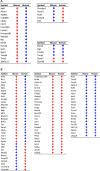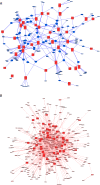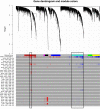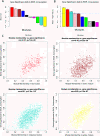Positively correlated miRNA-mRNA regulatory networks in mouse frontal cortex during early stages of alcohol dependence
- PMID: 24148570
- PMCID: PMC3924350
- DOI: 10.1186/1471-2164-14-725
Positively correlated miRNA-mRNA regulatory networks in mouse frontal cortex during early stages of alcohol dependence
Abstract
Background: Although the study of gene regulation via the action of specific microRNAs (miRNAs) has experienced a boom in recent years, the analysis of genome-wide interaction networks among miRNAs and respective targeted mRNAs has lagged behind. MicroRNAs simultaneously target many transcripts and fine-tune the expression of genes through cooperative/combinatorial targeting. Therefore, they have a large regulatory potential that could widely impact development and progression of diseases, as well as contribute unpredicted collateral effects due to their natural, pathophysiological, or treatment-induced modulation. We support the viewpoint that whole mirnome-transcriptome interaction analysis is required to better understand the mechanisms and potential consequences of miRNA regulation and/or deregulation in relevant biological models. In this study, we tested the hypotheses that ethanol consumption induces changes in miRNA-mRNA interaction networks in the mouse frontal cortex and that some of the changes observed in the mouse are equivalent to changes in similar brain regions from human alcoholics.
Results: miRNA-mRNA interaction networks responding to ethanol insult were identified by differential expression analysis and weighted gene coexpression network analysis (WGCNA). Important pathways (coexpressed modular networks detected by WGCNA) and hub genes central to the neuronal response to ethanol are highlighted, as well as key miRNAs that regulate these processes and therefore represent potential therapeutic targets for treating alcohol addiction. Importantly, we discovered a conserved signature of changing miRNAs between ethanol-treated mice and human alcoholics, which provides a valuable tool for future biomarker/diagnostic studies in humans. We report positively correlated miRNA-mRNA expression networks that suggest an adaptive, targeted miRNA response due to binge ethanol drinking.
Conclusions: This study provides new evidence for the role of miRNA regulation in brain homeostasis and sheds new light on current understanding of the development of alcohol dependence. To our knowledge this is the first report that activated expression of miRNAs correlates with activated expression of mRNAs rather than with mRNA downregulation in an in vivo model. We speculate that early activation of miRNAs designed to limit the effects of alcohol-induced genes may be an essential adaptive response during disease progression.
Figures







Similar articles
-
Integration of miRNA and protein profiling reveals coordinated neuroadaptations in the alcohol-dependent mouse brain.PLoS One. 2013 Dec 16;8(12):e82565. doi: 10.1371/journal.pone.0082565. eCollection 2013. PLoS One. 2013. PMID: 24358208 Free PMC article.
-
miRNA and mRNA expression profiling in rat brain following alcohol dependence and withdrawal.Cell Mol Biol (Noisy-le-grand). 2017 Feb 28;63(2):49-56. doi: 10.14715/cmb/2017.63.2.7. Cell Mol Biol (Noisy-le-grand). 2017. PMID: 28364783
-
Integrating mRNA and miRNA Weighted Gene Co-Expression Networks with eQTLs in the Nucleus Accumbens of Subjects with Alcohol Dependence.PLoS One. 2015 Sep 18;10(9):e0137671. doi: 10.1371/journal.pone.0137671. eCollection 2015. PLoS One. 2015. PMID: 26381263 Free PMC article.
-
MicroRNAs and ceRNAs: therapeutic implications of RNA networks.Expert Opin Biol Ther. 2014 Sep;14(9):1285-93. doi: 10.1517/14712598.2014.920812. Epub 2014 Jun 18. Expert Opin Biol Ther. 2014. PMID: 24941322 Review.
-
Embryonic stem cell microRNAs: defining factors in induced pluripotent (iPS) and cancer (CSC) stem cells?Curr Stem Cell Res Ther. 2009 Sep;4(3):168-77. doi: 10.2174/157488809789057400. Curr Stem Cell Res Ther. 2009. PMID: 19492978 Review.
Cited by
-
Functional roles, regulatory mechanisms and theranostics applications of ncRNAs in alcohol use disorder.Int J Biol Sci. 2023 Feb 21;19(4):1316-1335. doi: 10.7150/ijbs.81518. eCollection 2023. Int J Biol Sci. 2023. PMID: 36923934 Free PMC article. Review.
-
Identifying Interaction Clusters for MiRNA and MRNA Pairs in TCGA Network.Genes (Basel). 2019 Sep 11;10(9):702. doi: 10.3390/genes10090702. Genes (Basel). 2019. PMID: 31514484 Free PMC article.
-
Microglial-derived miRNA let-7 and HMGB1 contribute to ethanol-induced neurotoxicity via TLR7.J Neuroinflammation. 2017 Jan 25;14(1):22. doi: 10.1186/s12974-017-0799-4. J Neuroinflammation. 2017. PMID: 28118842 Free PMC article.
-
microRNA-132/212 deficiency enhances Aβ production and senile plaque deposition in Alzheimer's disease triple transgenic mice.Sci Rep. 2016 Aug 3;6:30953. doi: 10.1038/srep30953. Sci Rep. 2016. PMID: 27484949 Free PMC article.
-
Applying the new genomics to alcohol dependence.Alcohol. 2015 Dec;49(8):825-36. doi: 10.1016/j.alcohol.2015.03.001. Epub 2015 Mar 28. Alcohol. 2015. PMID: 25896098 Free PMC article. Review.
References
Publication types
MeSH terms
Substances
Grants and funding
LinkOut - more resources
Full Text Sources
Other Literature Sources
Medical
Molecular Biology Databases

